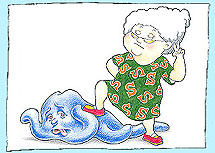Grammar: Sentence: Combining clauses in a sentence
| Binding clauses together (subordination) |
How do we recognise a binding relation?
There are several ways of binding an independent clause with a dependent clause. All use a grammatical form: conjunction, non-finite verb, or relative pronoun. Here are some examples of each way of binding:
Binding clauses with a subordinating conjunction
We bind independent clauses with dependent clauses using a 'subordinating conjunction' (while, besides, because, if):
| MegaMonster was angry independent clause because Granny Gong was ruining his evil plans. dependent clause |
 |
| When
the
ghost found no popcorn, dependent clause he became really grumpy. independent clause |
 |
The subordinating conjunction because in the clause because Granny Gong was ruining his evil plans is a dependent clause, and so the relation between the two clauses is a binding relation. Note that although Granny Gong was ruining his evil plans would be an independent clause if it occurred by itself, here it is a dependent clause because it is introduced by the subordinating conjunction because.
Binding clauses with a non-finite verb
We can also bind independent and dependent clauses using a 'non-finite' verb form (-ing form, to infinitive):
|
Feeling hungry,
// GrumpyGhost looked everywhere for food. Tired
of chasing GrumpyGhost,
// Granny Gong had a better idea. Granny Gong had to trick Grumpy Ghost // to
catch him. |
The non-finite verb forms feeling, tired and to catch tell us that these clauses are dependent, and that they are related to the independent clauses by binding.
As always, clauses related by binding can be reversed:
| To
catch him // Granny Gong had to trick Grumpy Ghost. dependent clause independent clause |
Such non-finite clauses are also referred to as '-ing participial clause' (walking, by walking), '-ed participial clause' (called, driven), and 'to-infinitive clause'. Note that the '-ed participial clause' includes clauses whose verbs end in -ed (called, walked), -en (driven, given) and other irregular endings (gone).
Binding clauses with a relative pronoun
We can also bind independent and dependent clauses using a 'relative pronoun' (which, who, that, whom):
| Granny was very smart, // which
was a good thing. independent clause dependent clause |
The relative pronoun in which was a good thing tells us that the clause is dependent, and that the clause is bound to the independent clause Granny was very smart.
|
Alternative terms |
|
| PrimeGram | Other grammars |
| linking relation | coordination |
| non-finite clause | -ing participial clause, -ed participial clause, to-infinitive clause |
Tell me more ... Subject in non-finite clauses related by binding |
|
||
To give us feedback about this section, click here or on the Comment button at the top of the screen.
If you have any questions about this section, visit the Language Corner.
If you have any questions or suggestions about how to teach this section, send a message to the Teaching Corner.